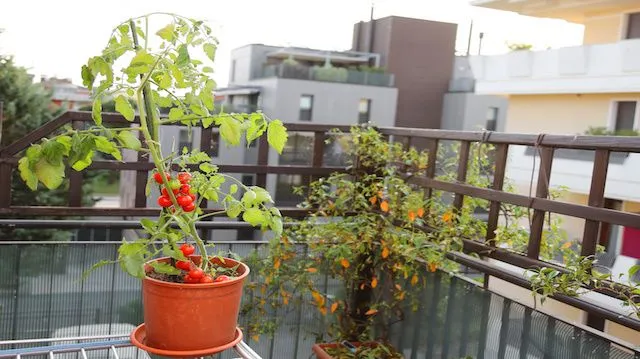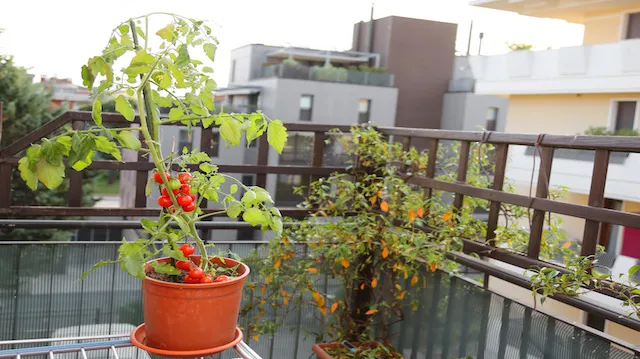
- Share on Facebook122
- Share on Pinterest
- Share on Twitter
Growing your own food has become a wonderful trend in the last few years, with people turning toward eating real food and wanting more naturally grown produce. Kids are even being taught gardening in schools!
You may feel left out of this movement if you don’t have a yard with a lot of space to grow your own fruits and veggies. Or perhaps you’d like to grow some food throughout the winter to supplement your diet. All of this is possible with container gardening.
Container gardening is a practice in which you don’t need to plant anything directly into the ground. Rather, you can use pots or other types of containers to hold enough soil to grow the plants. This makes a great garden because you can move things around easily and transfer plants indoors or outdoors according to the seasons.
You can even group plants together for decorative purposes or to keep pests away. Weeds are much less common in containers, so your garden will be relatively low-maintenance!
Many people grow small plants such as herbs in a pot on the windowsill, but container gardening has so much more potential! You can keep a steady crop of herbs, greens, vegetables and even tropical fruits producing throughout the year if you know what works in a pot and what doesn’t.
We’ve created a handy list to help you create an effective container garden, no matter what size your home or property is. The following are the 26 best things to grow in pots.
Oregano: This herb is low-maintenance and fragrant. Ensure the pot is at least 12 inches wide.
Basil: Ensure that a basil pot is well-drained, and prune the plant to encourage larger growth.
Tomatoes: Use cages or rods to keep tomato plants upright. Place in front of a warm, sunny wall that retains heat for plentiful tomatoes.
Potatoes: Plant chunks of potatoes and keep covering shoots with more soil as they grow.
Beets: Use a pot at least six inches deep to grow regular-sized beets, or choose a baby variety!
Turnips: Depth is important in order to be able to grow these root vegetables.
Carrots: Like many other root vegetables, carrots grow well in containers — particularly smaller varieties.
Parsley: This is a hardy herb that will grow under practically any condition!
Cucumber: Use a stake in the middle of the pot, and tie the vines to keep them upright.
Rosemary: Cut twigs from an existing plant, stick them in some soil and spray with water until roots begin to grow.
Peppers and chilis: These plants will need five or more hours of direct sunlight to grow.
Chives: One of the hardiest container plants that will come back year after year!
Peppermint: This aromatic herb is often grown in containers, and in regular gardens, because it is so voracious.
Strawberries: Keep these plants well-watered, since their shallow roots don’t retain moisture well.
Pineapple: Simply place the top of a pineapple in a pot and it will grow a new one!
Cantaloupe: Grow regular melons in a half whiskey barrel, or dwarf varieties in a five-gallon container.
Eggplant: Use a five-gallon container with a stake to support this trailing plant.
Lettuce and greens: Use a mix of seeds to grow your own ready-made salad!
Peas: Pot-grown pea plants require frequent watering and fertilization.
Onions: Use a pot that is at least 10 inches deep and has a wide mouth in order to grow onions.
Radishes: Ensure that radishes grown in a pot are well-drained to prevent rot.
Beans: These climbing plants can be placed next to a wall or railing to keep them off the ground.
Kale: A very hardy plant that can even withstand frost!
Chard: A five-gallon bucket or container is perfect to support the root growth of chard’s tall leaves.
Zucchini: Plant just one seed per pot, as zucchini plants are large.
Wheatgrass: This is a great way to get vitamins and antioxidants in your day, and you can simply grow it in a planting tray on the patio or windowsill. (Check out 30 reasons to add wheatgrass to your day.)
Some tips for container gardening
 Wondering how to choose the right pots or containers? Certain plants work better in different shapes and sizes of containers. In general, larger and deeper is better. More soil will be able to store more moisture in order to help plants survive.
Wondering how to choose the right pots or containers? Certain plants work better in different shapes and sizes of containers. In general, larger and deeper is better. More soil will be able to store more moisture in order to help plants survive.
You can improve growing conditions for your plants by layering a plastic pot inside of a clay pot. This way, you have the water retention capability of a plastic pot, with the pleasing appearance of a clay pot. You should also layer one inch of gravel at the bottom of the pot to help with drainage so that the water levels can balance naturally.
We recommend feeding plants once every two to three weeks using an organic fertilizer. You can also add trace elements to enrich the soil and get more nutritious produce. Finally, essential oils are an excellent solution for keeping pests away, instead of using chemicals.
Create a healthy food source for your family, even without a yard, with container gardening! One more thing: Learn how to take care of your plants with nontoxic pesticides and herbicides.
Do you have any great tips for container gardening? If so, please share!
—The Alternative Daily
Sources:
http://extension.uga.edu/publications/detail.cfm?number=C787
http://agnr.osu.edu/news/containers-let-gardeners-plant-flowers-vegetables-small-spaces
http://www.nybg.org/gardens/home-gardening/tips/container-gardening.php
https://www.ag.ndsu.edu/food/eatsmart/eat-smart.-play-hard.-magazines-1/2012-esph-magazine/the-art-and-science-of-container-gardening
http://www.almanac.com/content/container-gardening-vegetables
- Share on Facebook122
- Share on Pinterest
- Share on Twitter

